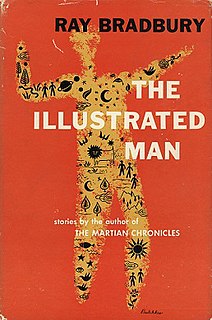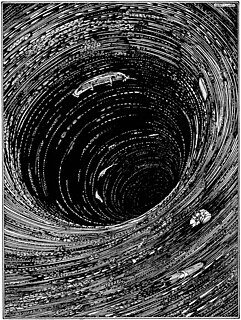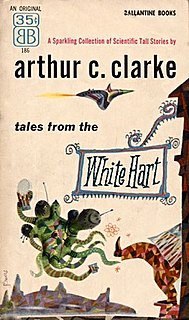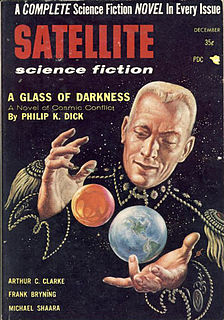Related Research Articles

Edgar Rice Burroughs was an American speculative fiction writer, best known for his prolific output in the adventure, science fiction and fantasy genres. His most well-known creations include Tarzan of the Apes, John Carter of Mars and Carson Napier of Venus.

The Martian Chronicles is a science fiction fix-up novel, published in 1950, by American writer Ray Bradbury that chronicles the settlement of Mars, the home of indigenous Martians, by Americans leaving a troubled Earth that is eventually devastated by nuclear war. The book is a work of science fiction, apocalyptic and post-apocalyptic fiction, dystopian fiction, and horror that projects American society immediately after World War II into a technologically advanced future where the amplification of humanity's potentials to create and destroy have both miraculous and devastating consequences.

The Illustrated Man is a 1951 collection of eighteen science fiction short stories by American writer Ray Bradbury. A recurring theme throughout the eighteen stories is the conflict of the cold mechanics of technology and the psychology of people. It was nominated for the International Fantasy Award in 1952.

Childhood's End is a 1953 science fiction novel by the British author Arthur C. Clarke. The story follows the peaceful alien invasion of Earth by the mysterious Overlords, whose arrival begins decades of apparent utopia under indirect alien rule, at the cost of human identity and culture.

"A Descent into the Maelström" is an 1841 short story by Edgar Allan Poe. In the tale, a man recounts how he survived a shipwreck and a whirlpool. It has been grouped with Poe's tales of ratiocination and also labeled an early form of science fiction.

Henry Patrick Clarke was an Irish stained-glass artist and book illustrator. Born in Dublin, he was a leading figure in the Irish Arts and Crafts Movement.

Richard Horatio Edgar Wallace was an English writer.

Tales from the White Hart is a collection of short stories by science fiction writer Arthur C. Clarke, in the "club tales" style.

The Collected Stories of Arthur C. Clarke, first published in 2001, is a collection of almost all science fiction stories written by Arthur C. Clarke. It includes 114 stories, arranged in order of publication, from "Travel by Wire!" in 1937 through to "Improving the Neighbourhood" in 1999. The story "Improving The Neighbourhood" has the distinction of being the first fiction published in the journal Nature. The titles "Venture to the Moon" and "The Other Side of the Sky" are not stories, but the titles of groups of six interconnected stories, each story with its own title. This collection is only missing a very few stories, for example "When the Twerms Came", which appears in his other collections More Than One Universe and The View from Serendip. This edition contains a foreword by Clarke written in 2000, where he speculates on the science fiction genre in relation to the concept of short stories. Furthermore, many of the stories have a short introduction about their publication history or literary nature.
Elizabeth and After is a novel by Matt Cohen, first published in 1999 by Knopf Canada. His final novel, it won the Governor General's Award for English-language fiction just a few weeks before Cohen's death.
"Patent Pending" is a science fiction short story by English writer Arthur C. Clarke, first published in 1954. It was also published as "The Invention". It later appeared in his collection Tales from the White Hart.
"Big Game Hunt" is a science fiction short story by the British writer Arthur C. Clarke, first published in 1956. This story describes the efforts of an eccentric professor to study the electrical circuitry of the brain. After using his research to develop robotic creatures, he then tries to use electrical stimulation of the brain to control the behavior of animals. The professor's work is discovered by a wildlife photographer, who tries to exploit it to film a giant squid. While their attempt is initially successful, the equipment blows a fuse, and the squid kills both scientist and photographer. The story was also published as "The Reckless Ones".
"Armaments Race" is a science fiction short story by British writer Arthur C. Clarke, first published in 1954, and later anthologized in Tales from the White Hart. Like the rest of the collection, it is a frame story set in the pub "White Hart", where the fictional Harry Purvis narrates the secondary tale.
"Critical Mass" is a science fiction short story by British writer Arthur C. Clarke, first published in 1949. This comic story describes the relationship between a village and a nuclear research facility located near it. On the day that the story takes place, a truck carrying a mysterious cargo has an accident, and the driver flees. The terrified villagers are about to begin an evacuation, when the narrator discovers that the cargo were merely hives of bees.
"Moving Spirit" is a science fiction short story by British writer Arthur C. Clarke, first published in 1957. The story within a comic story is narrated by Harry Purvis, who is called to assist a scientist relative of his in a trial. The scientist has been brought before the local magistrate's court on charges of illegally distilling liquor. Purvis manages to get him acquitted, by arguing that he was actually working on a fictional "osmotic bomb". Unfortunately Purvis accidentally demonstrates this bomb by exploding it in the courtroom, thus conveniently destroying all the evidence. However, the scientist is almost immediately booked for driving under the influence due to the strong smell of alcohol from his wet clothes.

"The Man Who Ploughed the Sea" is a science fiction short story by British writer Arthur C. Clarke, first published in 1957. The story within a story is narrated by Harry Purvis, who recalls a holiday spent submarining off of the Florida Keys. While there, he happens to witness a meeting between two wealthy and talented scientists, one of whom has designed a method to extract trace elements from seawater. He trades his secret to the other in exchange for the other's fancy yacht, but it turns out that the process is not yet commercially viable.

"The Reluctant Orchid" is a science fiction short story by British writer Arthur C. Clarke, first published in 1956, and later anthologized in Tales from the White Hart. Like the rest of the collection, it is a frame story set in the fictional "White Hart" pub, where the fictional Harry Purvis narrates the secondary tale.
"Cold War" is a science fiction short story by British writer Arthur C. Clarke, first published in 1956, and later anthologized in Tales from the White Hart. Like the rest of the collection, it is a frame story set in the fictional "White Hart" pub, where Harry Purvis narrates the secondary tale.
"What Goes Up" is a science fiction short story by English writer Arthur C. Clarke, first published in 1956, and later anthologized in Tales from the White Hart. Like the rest of the collection, it is a frame story set in the fictional White Hart pub, where Harry Purvis narrates the secondary tale. The title is a reference to the common phrase "What goes up must come down".
"Sleeping Beauty" is a science fiction short story by Arthur C. Clarke, first published in the magazine Infinity Science Fiction in April 1957, and later anthologized in Tales from the White Hart. Like the rest of the collection, it is a frame story set in the fictional pub "White Hart", where Harry Purvis narrates the secondary tale.
References
- ↑ "Bibliography: Let There be Light" . Retrieved 23 May 2014.CS1 maint: discouraged parameter (link)